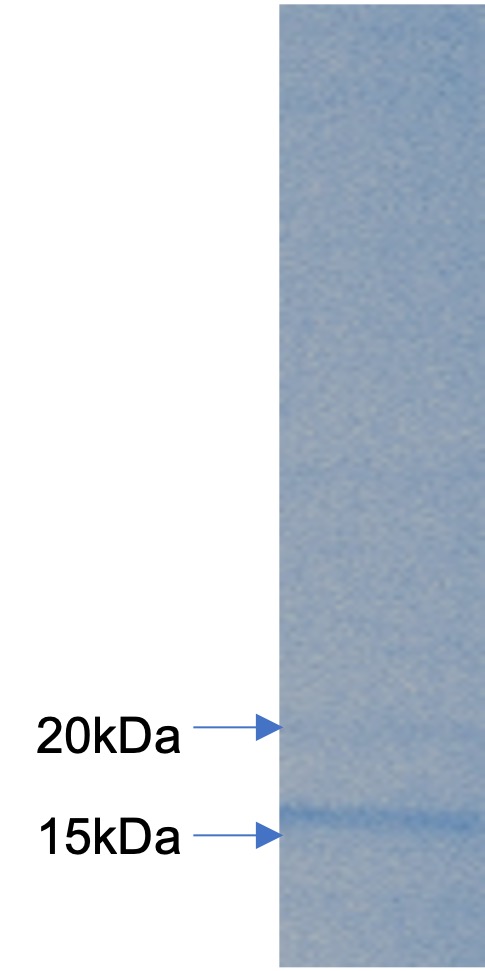Recombinant Mouse Legumain/Asparaginyl Endopeptidase (C-6His)
Shipping Info:
For estimated delivery dates, please contact us at [email protected]
| Amount : | 50 µg |
| Content : | Supplied as a 0.2 µm filtered solution of 20mM Tris,150mM NaCl,20% Glycerol,pH8.0. |
| Storage condition : | Store at -20°C, stable for 6 months after receipt. Please minimize freeze-thaw cycles. |
| AA sequence : | VPVGVDDPEDGGKHWVVIVAGSNGWYNYRHQADACHAYQIIHRNGIPDEQIIVMMYDDIANSEENPTPGVVINRPNGTDVYKGVLKDYTGEDVTPENFLAVLRGDAEAVKGKGSGKVLKSGPRDHVFIYFTDHGATGILVFPNDDLHVKDLNKTIRYMYEHKMYQKMVFYIEACESGSMMNHLPDDINVYATTAANPKESSYACYYDEERGTYLGDWYSVNWMEDSDVEDLTKETLHKQYHLVKSHTNTSHVMQYGNKSISTMKVMQFQGMKHRASSPISLPPVTHLDLTPSPDVPLTILKRKLLRTNDVKESQNLIGQIQQFLDARHVIEKSVHKIVSLLAGFGETAERHLSERTMLTAHDCYQEAVTHFRTHCFNWHSVTYEHALRYLYVLANLCEAPYPIDRIEMAMDKVCLSHYVDHHHHHH |
Source: Human Cells.
MW :48.7kD.
Recombinant Mouse Legumain/Asparaginyl Endopeptidase is produced by our Mammalian expression system and the target gene encoding Val18-Tyr435 is expressed with a 6His tag at the C-terminus. Mouse Legumain,also known as LGMN, is a cysteine protease belonging to peptidase family C13 and is expressed in kidney and placenta abundantly. LGMN has a strict specificity for hydrolysis of asparaginyl bonds. It can also cleave aspartyl bonds slowly, especially under acidic conditions. The mammalian legumain is involved in the processing of proteins for MHC class II antigen presentation in the lysosomal/endosomal system. It plays a role in the regulation of cell proliferation via its role in EGFR degradation. Legumain deficiency causes the accumulation of pro-Cathepsins B, H and L, another group of lysosomal cysteine proteases. Overexpression of Legumain in tumors is significant for invasion/metastasis. Mammalian legumain is inhibited by iodoacetamide and maleimides. Legumain activation appears to be autocatalytic and can be triggered by acidic pH.
MW :48.7kD.
Recombinant Mouse Legumain/Asparaginyl Endopeptidase is produced by our Mammalian expression system and the target gene encoding Val18-Tyr435 is expressed with a 6His tag at the C-terminus. Mouse Legumain,also known as LGMN, is a cysteine protease belonging to peptidase family C13 and is expressed in kidney and placenta abundantly. LGMN has a strict specificity for hydrolysis of asparaginyl bonds. It can also cleave aspartyl bonds slowly, especially under acidic conditions. The mammalian legumain is involved in the processing of proteins for MHC class II antigen presentation in the lysosomal/endosomal system. It plays a role in the regulation of cell proliferation via its role in EGFR degradation. Legumain deficiency causes the accumulation of pro-Cathepsins B, H and L, another group of lysosomal cysteine proteases. Overexpression of Legumain in tumors is significant for invasion/metastasis. Mammalian legumain is inhibited by iodoacetamide and maleimides. Legumain activation appears to be autocatalytic and can be triggered by acidic pH.
Endotoxin : Less than 0.1 ng/µg (1 IEU/µg) as determined by LAL test.
For Research Use Only. Not for use in diagnostic/therapeutics procedures.
| Subcellular location: | Lysosome |
| Post transnational modification: | Activated by autocatalytic processing at pH 4. |
| Tissue Specificity: | Detected in kidney proximal tubules (at protein level). Ubiquitous. Particularly abundant in kidney and placenta. |
| BioGrid: | 202402. 1 interactions. |
|
There are currently no product reviews
|

















.png)











